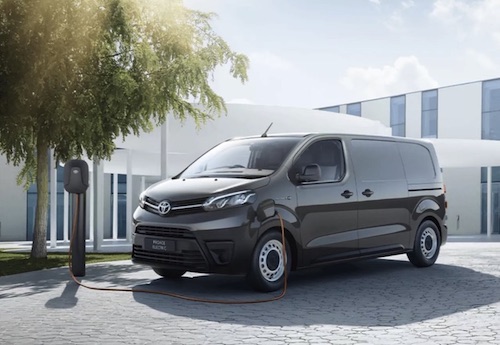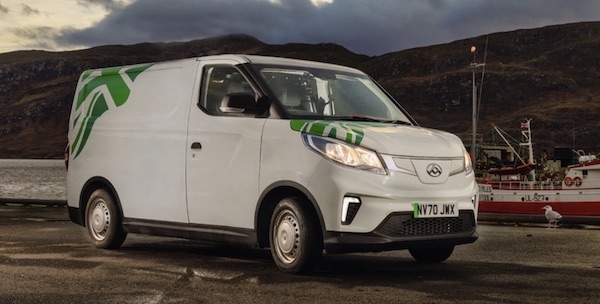Overview
Toyota Motor Corporation, known simply as Toyota, is a leading global automotive company. The company is one of the largest automobile manufacturers in the world and is headquartered in Aichi, Japan. The company has already established an enviable track record for the development and marketing of environment friendly hybrid vehicles. Toyota has one of the largest portfolios of mild hybrid electric vehicles (MHEVs), currently 11 hybrid models. It is also a world leader in fuel cell electric vehicles (FCEVs). Toyota’s portfolio of EVs, include passenger electric cars and commercial electric vehicles. The company currently has a portfolio of the following electric vans:
- Toyota Proace Electric
- Toyota Proace City Electric
Apart from the ubiquitous Toyota brand, the company also owns the Hino, Lexus, Ranz and Daihatsu brands.
Electric Cars: The Basics
For those of you new to zero-emission electric driving, we recommend a read of the following blog categories:
Sign up to the e-zoomed Electric Living newsletter
Toyota Proace Electric Panel Van
The Toyota Proace is built on a platform also shared by the PSA Group, so, much in common with the medium-sized commercial vans from Peugeot, Citroën and Vauxhall. The Proace Electric medium-sized panel van is available in two EV battery sizes: 50 kWh and 75 kWh.
It is always helpful to offer customers a choice in EV battery sizes. Though, both EV battery options offer a practical and useful EV range, we would recommend opting for the larger 75 kWh EV battery. For the long-term, it could give the business customer more flexibility in the use of the EV. It is also worth noting the class-leading EV battery warranty from Toyota (10 years or 100,000 miles).
Toyota claims an electric range up to 142 miles (WLTP) for the smaller 50 kWh EV battery and a range up to 205 miles (WLTP) for the 75 kWh EV battery. Of course, the real-world electric range will be lower, impacted by a number of factors, to include: payload, driving profile, speed, weather conditions, temperature, onboard services used etc. Expect a real-world e-range closer to 120 miles for the 50 kWh EV battery and 175 miles for the 75 kWh variant.
The manufacturer offers DC charging up to 100 kW DC. At 100 kW DC, the 50 kWh pure electric van can can be charged up to 80% in 32 minutes. The 75 kWh EV battery will take up to 48 minutes. In general, we at e-zoomed recommend never letting the EV battery charge fall below 10%. So best to plan the journey, such that there is always sufficient charge in the battery.
Toyota offers single-phase AC (7 kW) onboard charging compatibility, as standard. However, there is an option to upgrade to a three-phase (11 kW AC) onboard charger. We recommend upgrading to the 11 kW AC onboard EV charger, as most commercial premises in the UK have three-phase power supply (3-phase EV charging is faster compared to 1-phase EV charging!).
For those charging at home, a single-phase EV charger like, myenergi zappi is appropriate. Do keep in mind that most homes in the UK are powered by single-phase power supply. In any case, using a dedicated single-phase (7 kW) EV charger, the 50 kWh EV battery can be fully charged in 5 hours. The 75 kWh will take up to 8 hours to achieve 100% charge.
Though the e-van can be charged using a standard 3-PIN domestic plug, we at e-zoomed discourage using a domestic plug to charge an electric vehicle. The 50 kWh EV battery will take up to 14 hours for a full charge and the 75 kW EV battery will take up to 22 hours and 30 minutes. In any case, we at e-zoomed encourage a ‘topping up’ approach to charging an electric vehicle (EV). This is beneficial for the long-term maintenance of the onboard EV battery and of course, EV charging times are shorter.
The Proace Electric panel van is available in only one length (4959 mm). The electric van offers up to 5.8 m3 cargo volume, with a payload up to 1,226 kg. The EV offers a towing capacity up to 1,000 kg (Braked). The EV offers 3 seats. The manufacturer also offers a host of driving aids and technology, to include: cruise control, rear parking sensors, brake assist, hill-start assist, vehicle stability control and more. The EV incorporates a 7″ Pro Touch infotainment system compatible with Apple CarPlay & Android Auto.
In terms of performance, the front-wheel drive Proace Electric has a 100 kW onboard electric motor. The electric van delivers a maximum power up to 175 hp and 260 Nm torque. The e-van can achieve 0-62 mph in 13.3 seconds. The top speed is 80 mph. The electric van also incorporates regenerative braking to improve the efficiency of the EV and increase the electric range. The EV offers three driving modes.
The Proace Electric panel van is eligible for the UK government plug-in van grant for the ‘large vans’ category. These vehicles are between 2,500kg and 4,250kg gross vehicle weight, have CO2 emissions of less than 50g/km and can travel at least 96km (60 miles) without any emissions at all. The grant will pay for 35% of the purchase price for these vehicles, up to a maximum of £5,000.
Bottom-line, electric driving is good for the environment and the wallet! You can lease electric vans via e-zoomed at very competitive prices!
| PROS | CONS |
|---|---|
| Practical electric range | 11 kW AC onboard charger not standard |
| Available in two EV battery sizes | Available in only one length |
| Class-leading EV battery warranty | Choice of other electric vans |
The Toyota Proace Electric Panel Van (credit: Toyota)
| At A Glance | |
|---|---|
| EV Type: | Battery-Electric Vehicle (BEV) |
| Body Type: | Panel Van |
| Plug-In Van Grant (PiVG): | Available |
| Engine: | Electric |
| Available In UK: | Yes |
| Variants (2 Options) |
|---|
| Toyota Proace Electric Icon: 50kWh (from £40,915) |
| Toyota Proace Electric Icon: 75kWh (from £46,565) |
| EV Battery & Emissions | |
|---|---|
| EV Battery Type: | Lithium-ion |
| EV Battery Capacity: | Available in two battery sizes: 50 kWh/ 75 kWh |
| Charging: | 100 kW DC Rapid Charging (10%-80%: 32- 48 mins). Onboard charger 7kW/ 11kW AC (0%-100%: 5 hrs – 8 hrs) |
| Charge Port: | Type 2 |
| EV Cable Type: | Type 2 |
| Tailpipe Emissions: | 0g (CO2/km) |
| EV Battery Warranty: | 10 years or 100,000 miles |
| Charging Times (Overview) | |
|---|---|
| Slow charging AC (3 kW – 3.6 kW): | 6 – 12 hours (dependent on size of EV battery & SOC) |
| Fast charging AC (7 kW – 22 kW): | 3 – 8 hours (dependent on size of EV battery & SoC) |
| Rapid charging AC (43 kW): | 0-80%: 20 mins to 60 mins (dependent on size of EV battery & SoC) |
| Rapid charging DC (50 kW+): | 0-80%: 20 mins to 60 mins (dependent on size of EV battery & SoC) |
| Ultra rapid charging DC (150 kW+): | 0-80% : 20 mins to 40 mins (dependent on size of EV battery & SoC) |
| Tesla Supercharger (120 kW – 250 kW): | 0-80%: up to 25 mins (dependent on size of EV battery & SoC) |
- Note 1: SoC: state of charge
| Dimensions | |
|---|---|
| Height (mm): | 1940 |
| Width (mm): | 1920 |
| Length (mm): | 4959 |
| Wheelbase (mm): | 3275 |
| Turning Radius (m): | 6.20 |
| Cargo Volume (m3): | 5.8 |
| Payload (kg): | 1,000 – 1,226 |
| Proace 50 kWh | |
|---|---|
| EV Battery Capacity: | 50 kWh |
| Pure Electric Range (WLTP): | 142 miles |
| Electric Energy Consumption (kWh/100 km): | N/A |
| Charging: | 100 kW DC Rapid Charging (10%-80%: 32 mins). Onboard charger 7 kW/ 11 kW AC (0%-100%: 5 – 8 hrs) |
| Top Speed: | 80 mph |
| 0-62 mph: | 12.1 seconds |
| Drive: | Front-Wheel Drive (FWD) |
| Max Power (hp): | 150 |
| Torque (Nm): | 260 |
| Transmission: | Automatic |
| Seats: | 3 |
| Towing Capacity/ Braked (kg): | 1,000 |
| Gross Vehicle Weight (kg): | 3,100 |
| Colours: | 4 |
| NCAP Safety Rating: | Five-Star |
| Proace 75 kWh | |
|---|---|
| EV Battery Capacity: | 75 kWh |
| Pure Electric Range (WLTP): | 205 miles |
| Electric Energy Consumption (kWh/100 km): | N/A |
| Charging: | 100 kW DC Rapid Charging (10%-80%: 48 mins). Onboard charger 7 kW/ 11 kW AC (0%-100%: 5 – 8 hrs) |
| Top Speed: | 80 mph |
| 0-62 mph: | 13.3 seconds |
| Drive: | Front-Wheel Drive (FWD) |
| Max Power (hp): | 175 |
| Torque (Nm): | 260 |
| Transmission: | Automatic |
| Seats: | 3 |
| Towing Capacity/ Braked (kg): | 1,000 |
| Gross Vehicle Weight (kg): | 3,025 |
| Colours: | 4 |
| NCAP Safety Rating: | Five-Star |
While e-zoomed uses reasonable efforts to provide accurate and up-to-date information, some of the information provided is gathered from third parties and has not been independently verified by e-zoomed. While the information from the third party sources is believed to be reliable, no warranty, express or implied, is made by e-zoomed regarding the accuracy, adequacy, completeness, legality, reliability or usefulness of any information. This disclaimer applies to both isolated and aggregate uses of this information.









































